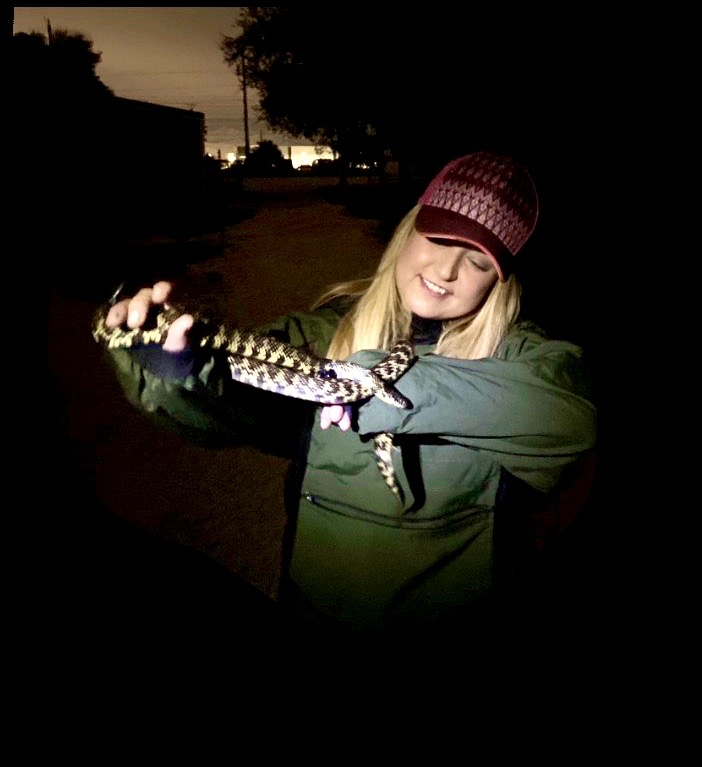COSAM Graduate Progresses Knowledge on Python Parasite
Melissa Miller, a Ph.D. graduate from the Auburn University Department of Biological Sciences, saw her first snake while on a walk with her mother in the woods as a child. From then on, she was hooked.
“As I grew older the fascination continued and I wanted to learn everything I could about them,” she shared.
A publication from Miller’s dissertation research while studying at Auburn, which focused on a nonnative pentastomid parasite introduced to southern Florida by Invasive Burmese pythons, was recently published in the science journal “Ecosphere.” The project was funded by the Auburn University Center for Environmental Studies at the Urban-Rural Interface, as well as the Department of Biological Sciences.
Miller graduated with an undergraduate degree in biological sciences from Northern Kentucky University. While earning a master’s degree in biological sciences from Sam Houston State University in Texas, Miller studied cottonmouth and copperhead snakes, as well as the invasive Boa constrictor in Aruba.
“I decided to pursue my doctoral studies at Auburn because of the expertise of the faculty at Auburn, especially my co-advisors, Drs. Craig Guyer and Christina Romagosa, and the wealth of available resources, from the laboratories to the RBD Library, as well as the opportunities for professional development that would be available to me during my graduate work,” Miller explained.
Miller’s research on pythons began after lung parasites were being discovered during necropsies of wild-caught invasive pythons in Florida. Scientists were unaware whether the parasite was from the pythons’ native range in Southeast Asia, or if it was a parasite that pythons contracted in southern Florida.
“There are important implications for either outcome as far as the impact pythons can have on native wildlife,” Miller said. “I decided to take on the challenge to find out the answer during my dissertation work at Auburn.”
The research team examined native snakes and invasive pythons collected from Florida to determine the degree to which parasite spillover is occurring. They found the parasite infected 13 species of native snakes collected from areas in the same geographic area of pythons. Prevalence and infection intensity of the parasite were significantly higher among native snakes compared with pythons.
The team also discovered that adult female parasites achieved larger sizes and represented a greater proportion of the overall parasite population in native snakes vs. pythons, indicating native snakes are more competent hosts of the parasite than pythons.
Native snakes collected from regions within geographical areas with pythons present as well as from regions where pythons are absent were also examined to determine how far the parasite has spread. An infected snake was found 348 km north of the northernmost infected python. The research showed that native snakes are highly competent hosts of the parasite and have facilitated the rapid spread of the parasite beyond the range of its invasive host.
Miller said that the parasite has the potential to negatively affect snakes because it is a parasite that is new to native snakes in North America.
“Our snakes have not co-evolved with this parasite so the effects of infection may be exacerbated as North American snakes are immunologically naïve and are not pre-adapted to combat infection by this parasite,” she said. “This may lead to declines in native snake populations.”
Miller’s former advisor and Department of Biological Sciences doctoral graduate Christina Romagosa, currently a research associate professor in the Department of Wildlife Ecology and Conservation at the University of Florida, added that co-introduced pathogens and parasites, such as these lung parasites, are not often considered in the research and management of biological invasions.
“This study adds to the growing knowledge of disease impacts associated with the global movement of animals,” she said.
Miller recently accepted a position with the University of Florida as coordinator of invasive species research working at the UF-IFAS Research and Education Center in Fort Lauderdale. She is continuing the research she conducted at Auburn by working with invasive species in South Florida, with a focus on pythons, Nile monitor and Argentine black and white tegu lizards, and caiman.
Miller said she believes the research she conducted at Auburn was important because invasive species are among the leading threats to native wildlife.
“Identifying the impacts of invasive species is critical to understanding how native wildlife are affected during biological invasions,” she said. “My study documents that a parasite introduced by Burmese pythons has infected half of the snake species in extreme southern Florida (Miami-Dade and Monroe counties) and has spread to native snakes outside of the pythons range in Florida through highly susceptible native snake hosts. This shows that invasive species, such as Burmese pythons, can have far-reaching effects well beyond their invasive range.”
Latest Headlines
-
04/12/2024
-
04/02/2024
-
04/02/2024
-
04/02/2024
-
03/27/2024

